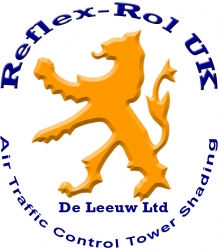Reflex-Rol U.K.
Anti-Glare Roller Blinds For Air Traffic Control Towers
The Reflex-Rol Aviation System is an anti-glare roller blind designed to give optimum vision control when fitted to the unique window shapes and angles of air traffic control towers. As these windows are often inclined to minimise the effect of reflection, it is important that the shade closely follows the glass in a parallel manner to avoid distortion of vision. Over 25 years of development enables the Aviation System anti-glare roller blind to do just this.
Systems can be operated manually, electro-mechanically or electronically, offering a top-to-bottom or a bottom-to-top drop. Depending on the sizes of the shades, 24VDC, 110VAC or 230VAC motors will be deployed.
Reflex-Rol produces a range of shading materials as well as anti-glare roller blinds, the AR760 being the airport and control tower standard. Other materials are also available for more standard office-type installations, whether a normal vertical window, or an inclined or horizontal skylight. The Aviation System can also be deployed in many other non-standard-shape windows.
View our Aviation Shading Brochure
Company Profile
-
Light Filter for Anti-Glare Roller Blinds
Selected from Reflex-Rol’s wide range of specialist filters, the AR760 light filter with its T65 value of 4.7% and colour reproduction value of 78% has been found to be the most popular worldwide. The hardware has developed so the moving shade is both held in place and guided by tensioned side wires.
Key to the successful operation of the AR760 light filter is its precision telescopic bottom bar.
The telescopic elements of the bar are precision engineered, ensuring a very smooth action under all circumstances. The ‘eyelet’ at the end of the telescope follows the line of the high tension stainless steel cable with precision, ensuring that the units rolls smoothly along the inclined position of the glass. This is a critical factor in making sure the AR750 ‘Aviation’ reflector remains smooth and taut at all times.
Simple installations are available with manual operation. More demanding applications can incorporate motors and pulleys as required.
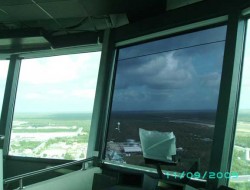
-
Commercial and Military Anti-Glare Roller Blinds
Reflex-Rol UK surveys, designs and installs the anti-glare roller blind internationally. Recent installations include the Cancun Tower in Mexico, a tower in Tete in Mozambique, different towers in the UAE and across Europe of which Heathrow, Charles de Gaulle in Paris and Kloten in Zurich are the most famous ones.
Reflex-Rol UK has provided anti-glare roller blinds for the commercial and military sectors.
A number of Mobile Air Traffic Control Towers have also been fitted out on behalf of the Royal Air Force and are serving in severe climate conditions.
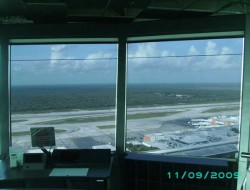
-
Visual Control Room (VCR) Shading
Even Better Sight
ATC towers are designed to enable air traffic controllers to see well, but Reflex-Rol anti-glare roller blinds enable them to see better.
360 Degrees vision from the tower is what towers are designed for but this vision diminishes substantially with low angles of Sun. This can cause an airport to go to ‘reduced visibility’ status, meaning fewer landing and take-offs are allowed. This means a loss of revenue for the airport.
Depending on the size of the airport and the planes in question, this can mean that one missed landing or take-off could have paid for the shading in the tower.
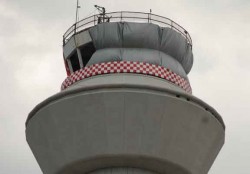
-
VCR Glare Control - VCR Roller Blind/Shading Systems
The Company
De Leeuw Ltd., as a legal entity, was formed in January 1983 and its trading name was, and still is, REFLEX-ROL U.K. Reflex-Rol U.K. specialises in ‘out of the ordinary’ type of Solar and Glare Shading solution and the very first tower we were asked to do was the Apron Control Tower at Birmingham (U.K.) airport in the 1980’s. That was the beginning of a special division within the company solving problems in control rooms in general and ATC’s in particular. The rest, as goes the saying….is history .
It would not be wise to claim the company has not felt the effects of the current recession as growth has not been as quick as previous years. But despite the current situation, we are still growing.
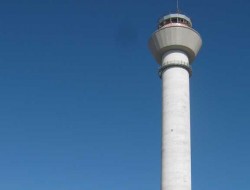
-
Check-in Shutters
Security is a major issue at most airports and it is more astounding that most check-
in areas are what can only be described as ‘open doors’ to the airside operations of the airport. Small flappy plastic strips hang in the openings through which suitcases go into the baggage handling area. This baggage handling area is supposed to be a secure area as from there one has free access to the rest of the airfield behind security. If no flights are leaving or no luggage is being checked- in, these positions are not manned and anybody is free to crawl through and find themselves ‘airside’. Need we say more ….? The De Leeuw Ltd. Check-
in shutter can be operated in many different ways; a simple push button in a locked cabinet, a simple key operated switch or fully automatic which operates the shutter a moment or two before the conveyor belt starts to roll. It will then shut automatically when the conveyor belt stops. Based on the Front Security B60 aluminium folding gate. The check-
in conveyor shutter is adjusted to the rails of the conveyor by creating coves at the bottom slat. The bottom slat is equipped with polyethylene at all the edges of the coves. The check- in conveyor shutter has been designed in cooperation with the Technical Department of Aeroport de Paris, ADP. The check-
in conveyor shutter has been developed to prevent unauthorized individuals to enter the luggage ‘airside’ luggage areas via the conveyor belts. 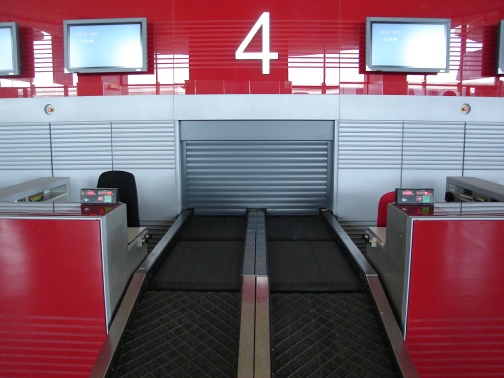
-
Sequential Shutters for Passenger Boarding Bridges
The passenger boarding bridge sequential safety shutter found its origin and is based on the principles of the Front Vision Transparent Shutter System.
The Sequential Passenger Boarding Bridge Shutter has been developed in cooperation with the technical department of Aeroport de Paris, ADP. The shutter consists of two parts connected with heavy-
duty straps, and opens in two stages. At first, when the operator opens the upper part of the ‘curtain’, the lower part remains in place. During maneuvering of the bridge towards the plane, the lower part of the curtain functions as a safety barrier. When the bridge is close enough to the plane, the lower part can easily be opened and ground- crew and passengers can come through. The sequential shutter is designed as a replacement of the existing shutter or door. It makes sure the operator has a clear view of what happens around and in front of him/her. Now the operator has the possibility to wait until the last moment before he/she opens the shutter. During the process, the operator will be well protected against all weather conditions.
The transparent shutter is equipped with safety devices that prevent any pinching of feet, hands and fingers when the shutter is opened and closed. We can also supply the shutter with an automatic control unit with only two buttons for full control of all functions.
The shutters are basically constructed of aluminium and polycarbonate. For the hinges, we use high quality extruded and anodized aluminium. The guides and the enclosure are made of light grey anodised aluminium.
The see-
through windows are made of polycarbonate, named Durolon® VR 2200, with special additives which protect against chemical solutions and also a UV stabilizer. After several years, the light transmittance of the window will still be 90% of the original value (89%). 
Images
Contact
De Leeuw Ltd.
Ryeford Hall
Ryeford
Ross-on-Wye
Herefordshire
United Kingdom
HR9 7PU
- +44 (0) 1989 750005
